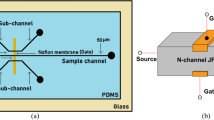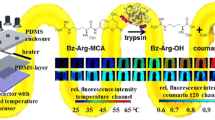Abstract
A new method has been developed for liquid–liquid microextraction utilizing a circulation microchannel. A glass microchemical chip having a circular shallow microchannel in contact with a surrounding deeper microchannel was fabricated by a two-step photolithographic wet-etching technique. Surface modification reagent was selectively introduced to the shallow channel by utilizing capillary force, and the surface of the shallow channel was selectively made hydrophobic. With the aid of the hydrophobic/hydrophilic surface patterning, it was possible to keep organic solvent in the circular channel while the aqueous sample solution was continuously flowing in the deep channel. As a result, concentration extraction from sample solution to stationary extractant with a nanoliter scale volume became possible. Concentration extraction has been difficult in a multiphase continuous flow. Function of the newly developed microextraction system was verified with methyl red as a test sample, and concentration extraction to reach equilibrium was successfully carried out. A novel surface modification method utilizing frozen liquid as a masking material was also developed as a reverse process to make the shallow channel hydrophilic and the deep channel hydrophobic. Visualization of circulation motion inside the circular shallow channel induced by flow in the deep channel was observed with a particle tracing method.




Similar content being viewed by others
Abbreviations
- CARM:
-
capillary restricted modification
- ODS:
-
octadecyltrichlorosilane
- TLM:
-
thermal lens microscopy (or microscope)
References
Psillakis E, Kalogerakis N (2002) Developments in single-drop microextraction. Trends Anal Chem 21:53–63
Psillakis E, Kalogerakis N (2003) Developments in liquid-phase microextraction. Trends Anal Chem 22:565–574
He Y, Lee HK (1997) Liquid-phase microextraction in a single drop of organic solvent by using a conventional microsyringe. Anal Chem 69:4634–4640
Liu W, Lee HK (2000) Continuous-flow microextraction exceeding 1000-fold concentration of dilute analytes. Anal Chem 72:4462–4467
Kogi O, Kim H-B, Kitamura N (2000) Microinjection-microspectroscopy of single oil droplets in water: an application to liquid/liquid extraction under solution-flow conditions. Anal Chim Acta 418:129–135
Chen H, Fang Q, Yin X-F, Fang Z-L (2005) Microfluidic chip-based liquid–liquid extraction and preconcentration using a subnanoliter-droplet trapping technique. Lab Chip 5:719–725
Tokeshi M, Kikutani Y, Hibara A, Sato K, Hisamoto H, Kitamori T (2003) Chemical processing on microchips for analysis, synthesis, and bioassay. Electrophoresis 24:3583–3594
Tokeshi M, Minagawa T, Uchiyama K, Hibara A, Sato K, Hisamoto H, Kitamori T (2002) Continuous-flow chemical processing on a microchip by combining microunit operations and a multiphase flow network. Anal Chem 74:1565–1571
Surmeian M, Slyadnev M, Hisamoto H, Hibara A, Uchiyama K, Kitamori T (2002) Three-layer flow membrane system on a microchip for investigation of molecular transport. Anal Chem 74:2014–2020
Goto M, Sato K, Murakami M, Tokeshi M, Kitamori T (2005) Development of a microchip-based bioassay system using cultured cells. Anal Chem 77:2125–2131
Squires TM, Quake SR (2005) Microfluidics: fluid physics at the nanoliter scale. Rev Mod Phys 77:977–1026
Zhao B, Moore JS, Beebe DJ (2001) Surface-directed liquid flow inside microchannels. Science 291:1023–1026
Hibara A, Nonaka M, Hisamoto H, Uchiyama K, Kikutani Y, Tokeshi M, Kitamori T (2002) Stabilization of liquid interface and control of two-phase confluence and separation in glass microchips by utilizing octadecylsilane modification of microchannels. Anal Chem 74:1724–1728
Hibara A, Iwayama S, Matsuoka S, Ueno M, Kikutani Y, Tokeshi M, Kitamori T (2005) Surface modification method of microchannels for gas–liquid two-phase flow in microchips. Anal Chem 77:943–497
Smirnova A, Mawatari K, Hibara A, Proskurnin MA, Kitamori T (2006) Micro-multiphase laminar flows for the extraction and detection of carbaryl derivative. Anal Chim Acta 558:69–74
Kitamori T, Tokeshi M, Hibara A, Sato K (2004) Thermal lens microscopy and microchip chemistry. Anal Chem 76:52A–60A
Matsuoka S, Hibara A, Ueno M, Kitamori T (2006) Supercooled micro flows and application for asymmetric synthesis. Lab Chip 6:1236–1238
Song H, Bringer MR, Tice JD, Gerdts CJ, Ismagilov RF (2003) Experimental test of scaling of mixing by chaotic advection in droplets moving through microfluidic channels. Appl Phys Lett 83:4664–4666
Yen BKH, Günther A, Schmidt MA, Jensen KF, Bawendi MG (2005) A microfabricated gas–liquid segmented flow reactor for high-temperature synthesis: the case of CdSe quantum dots. Angew Chem Int Ed 44:5447–5451
Shinohara K, Sugii Y, Aota A, Hibara A, Tokeshi M, Kitamori T, Okamoto K (2004) High-speed micro-PIV measurements of transient flow in microfluidic devices. Meas Sci Technol 15:1965–1970
Acknowledgements
We gratefully acknowledge a grant-in-aid from the Ministry of Education, Science, Sports and Culture, Japan (no. 15710108 to YK). We thank Dr. Kazuma Mawatari for the discussion and Dr. Arata Aota for the assistance in flow visualization.
Author information
Authors and Affiliations
Corresponding author
Electronic supplementary material
Below is the link to the electronic supplementary material.
Supplement 1
kikutani_etal (MPG 3.6 mb)
Rights and permissions
About this article
Cite this article
Kikutani, Y., Mawatari, K., Hibara, A. et al. Circulation microchannel for liquid–liquid microextraction. Microchim Acta 164, 241–247 (2009). https://doi.org/10.1007/s00604-008-0065-7
Received:
Accepted:
Published:
Issue Date:
DOI: https://doi.org/10.1007/s00604-008-0065-7




